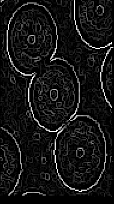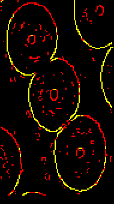With gradient (ex: SoGradientOperatorProcessing2d) or laplacian (ex: SoRecursiveLaplacianProcessing) engines, a 1D edge was defined as the local maximum of the magnitude of the first derivative, or the zero crossing of the second derivative. Unfortunately, this definition cannot be extended to 2D functions (like for instance SoGradientLocalMaximaProcessing2d). In fact, an edge appears like a crest line on the magnitude of the gradient image and this leads us to define an edge as all the points whose gradient magnitude is maximum along the direction of the gradient, i.e the direction across the edge. This method, referred to as non-maxima suppression, provides thin lines which are much more convenient to handle.
Note that images of zero crossings of the Laplacian result in closed thin lines as they correspond to boundaries between positive and negative regions. Finally, we can take into account the specific geometry of a contour - its pixels are connected by using a more sophisticated threshold, the threshold by hysteresis (SoHysteresisThresholdingProcessing).
This is in fact an intuitive method. We choose a high and low threshold, 









